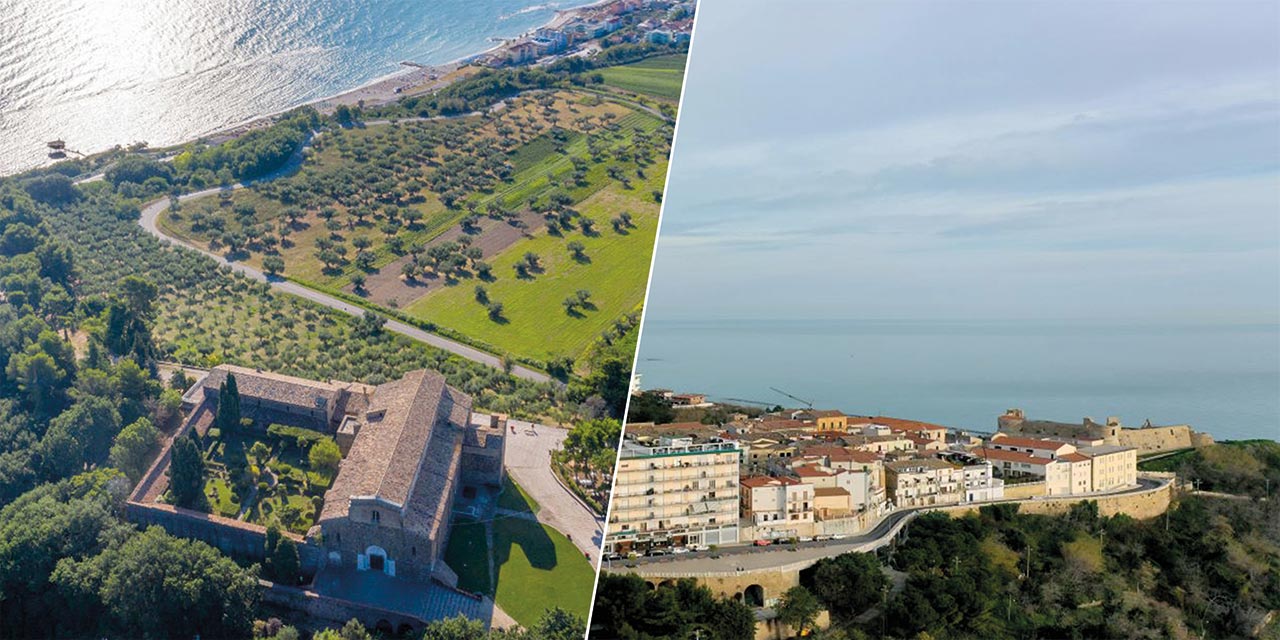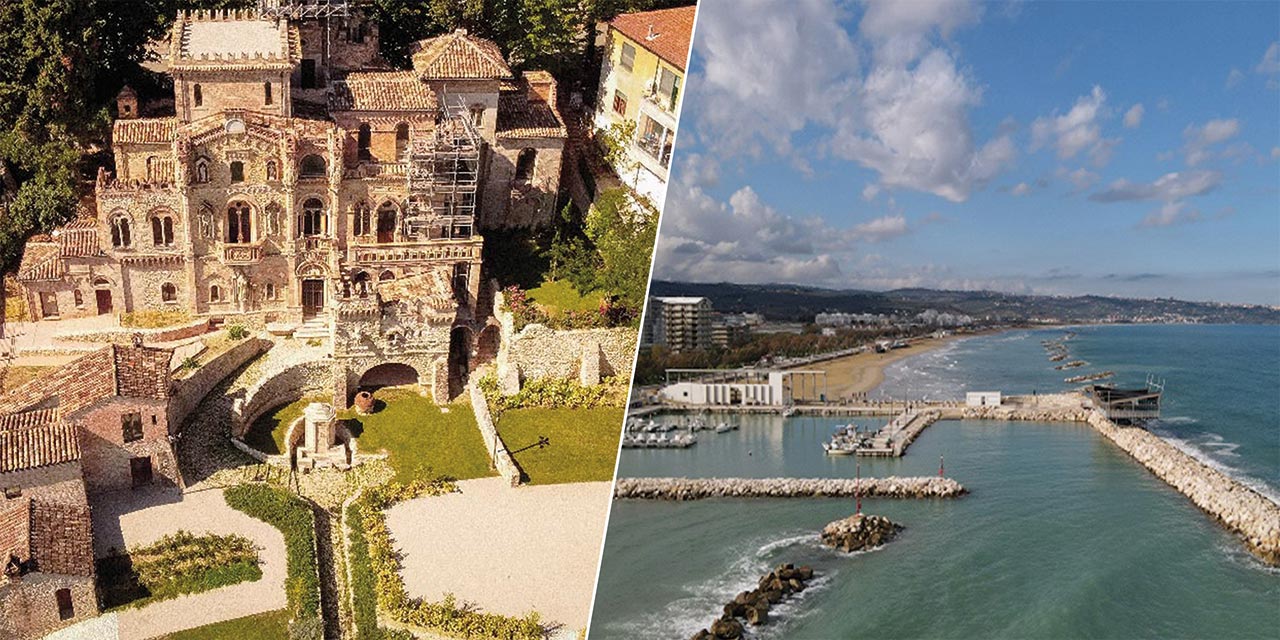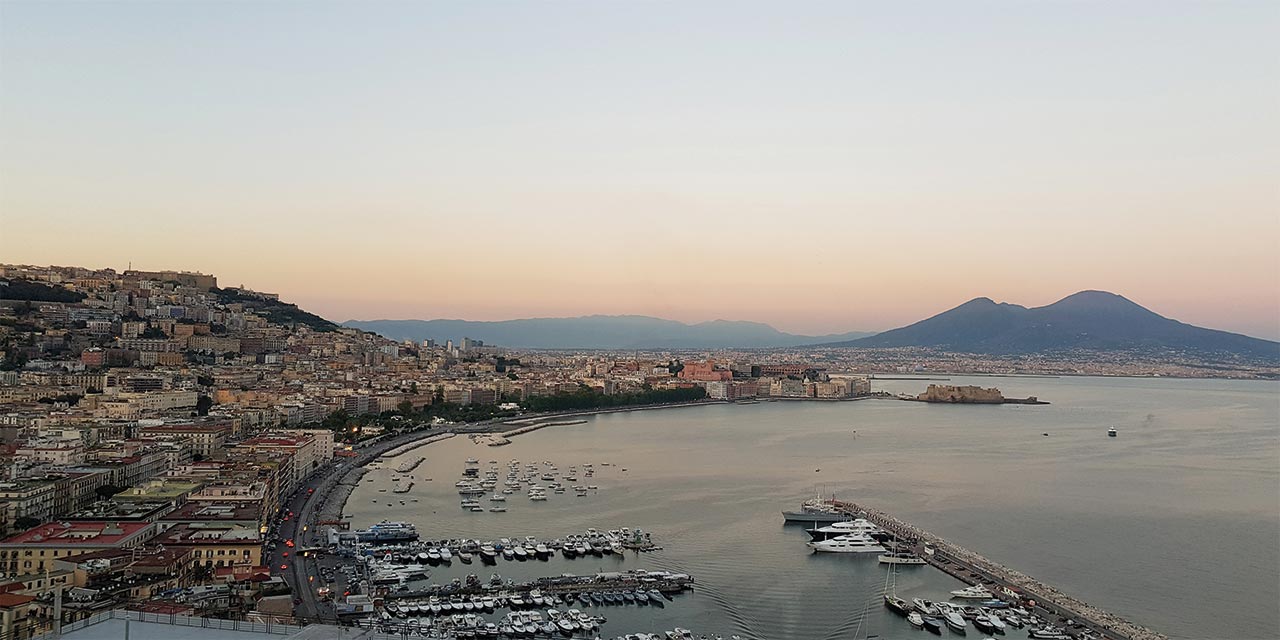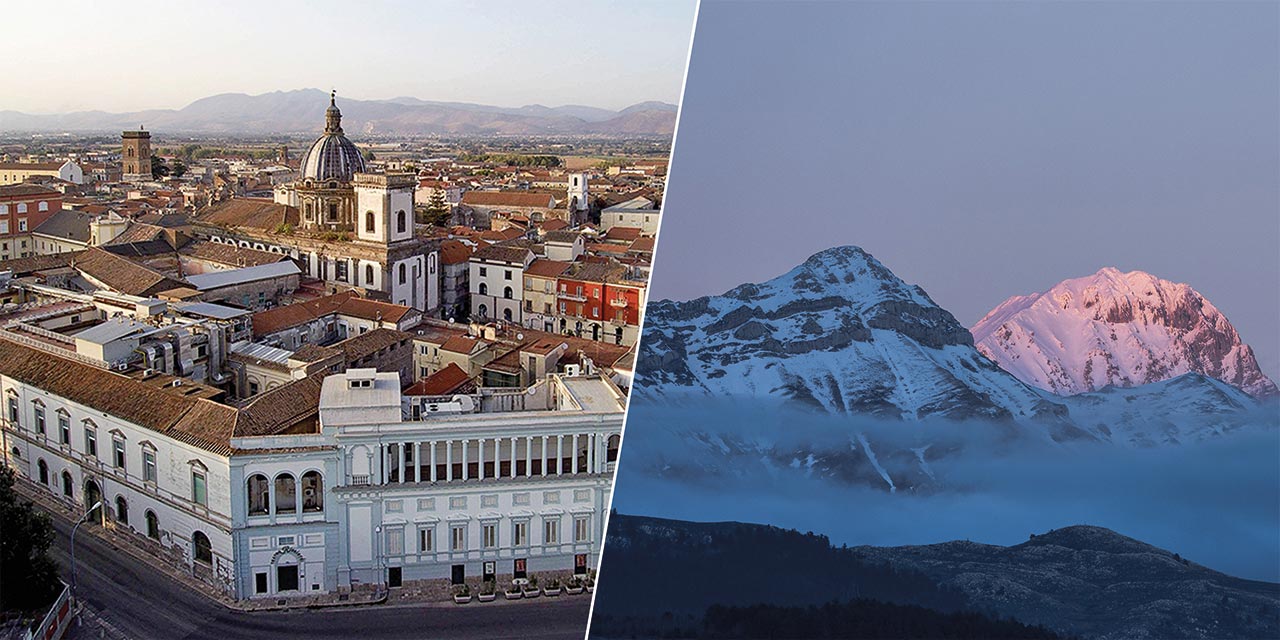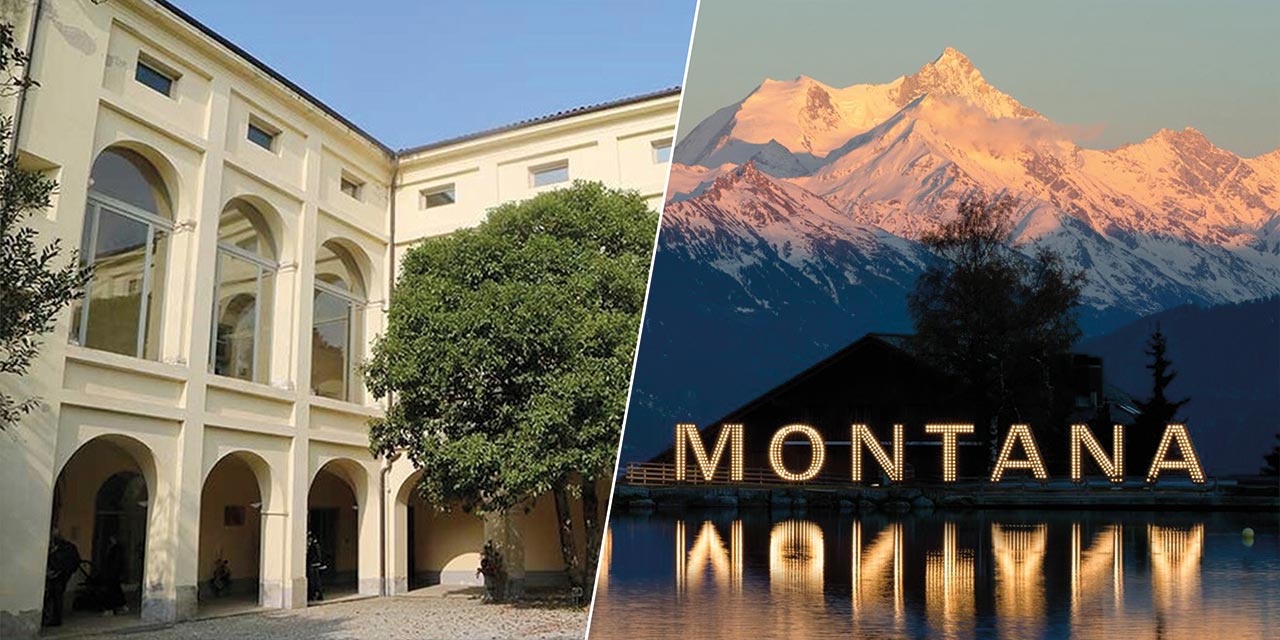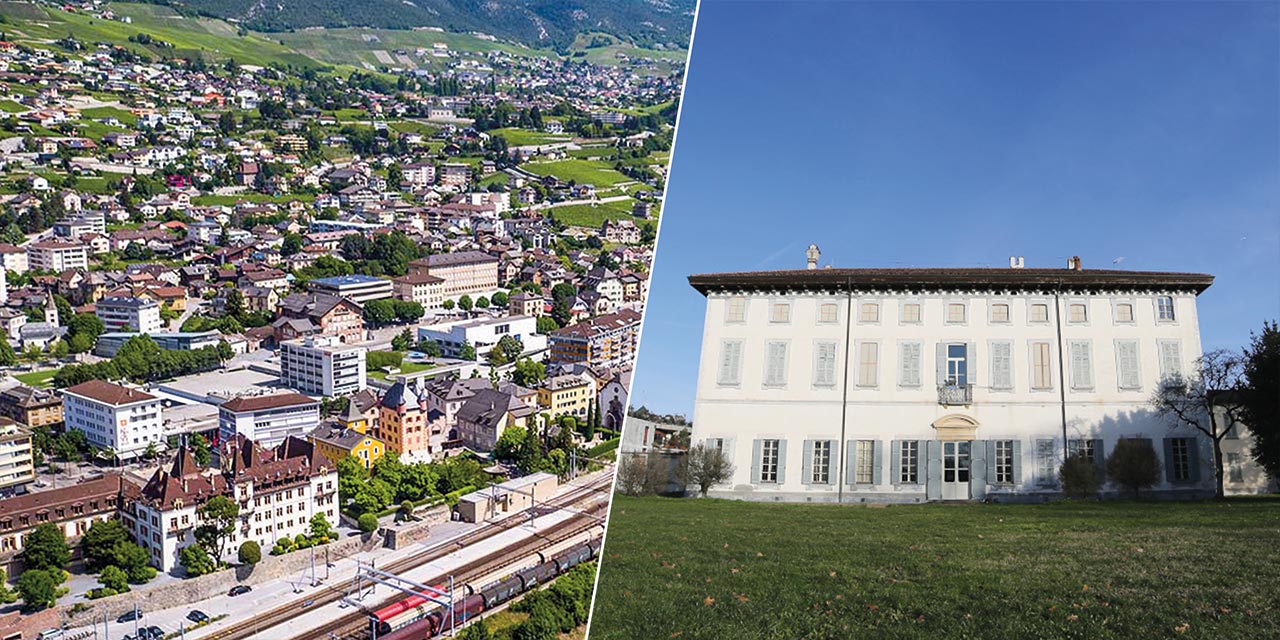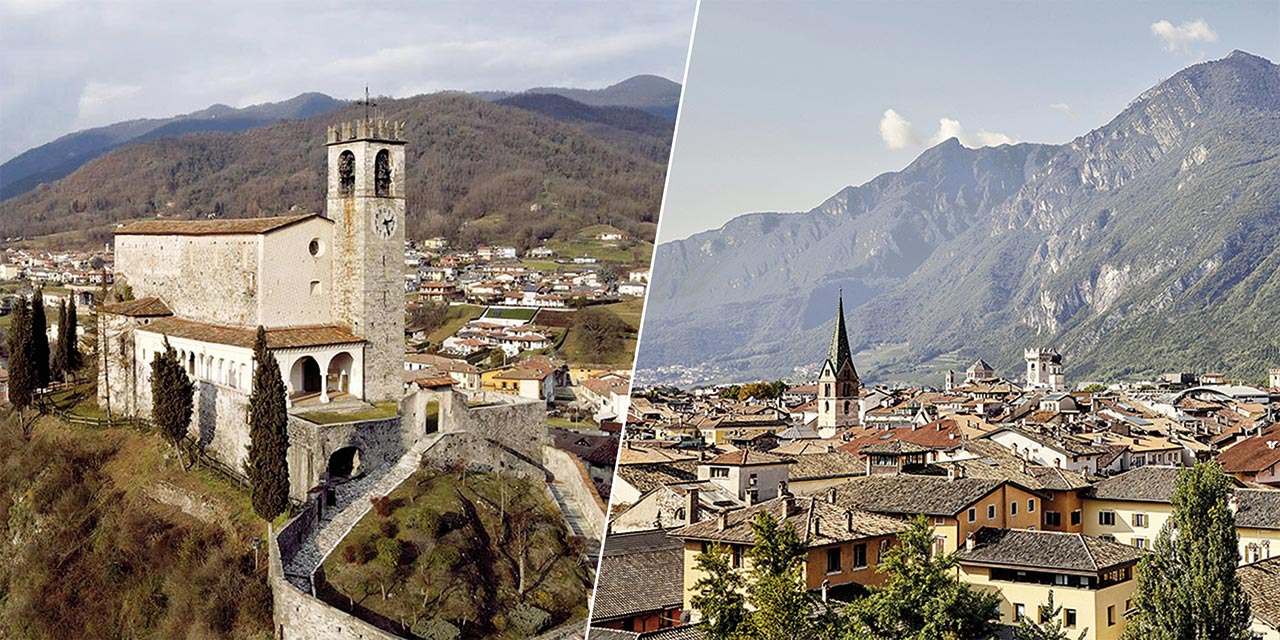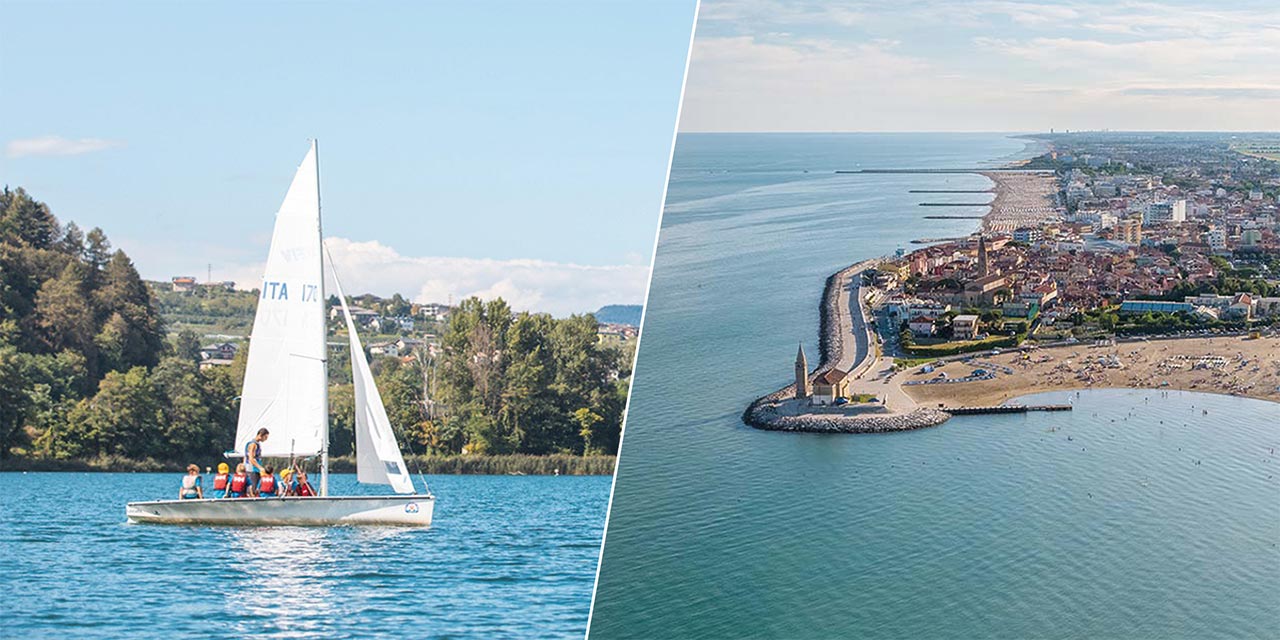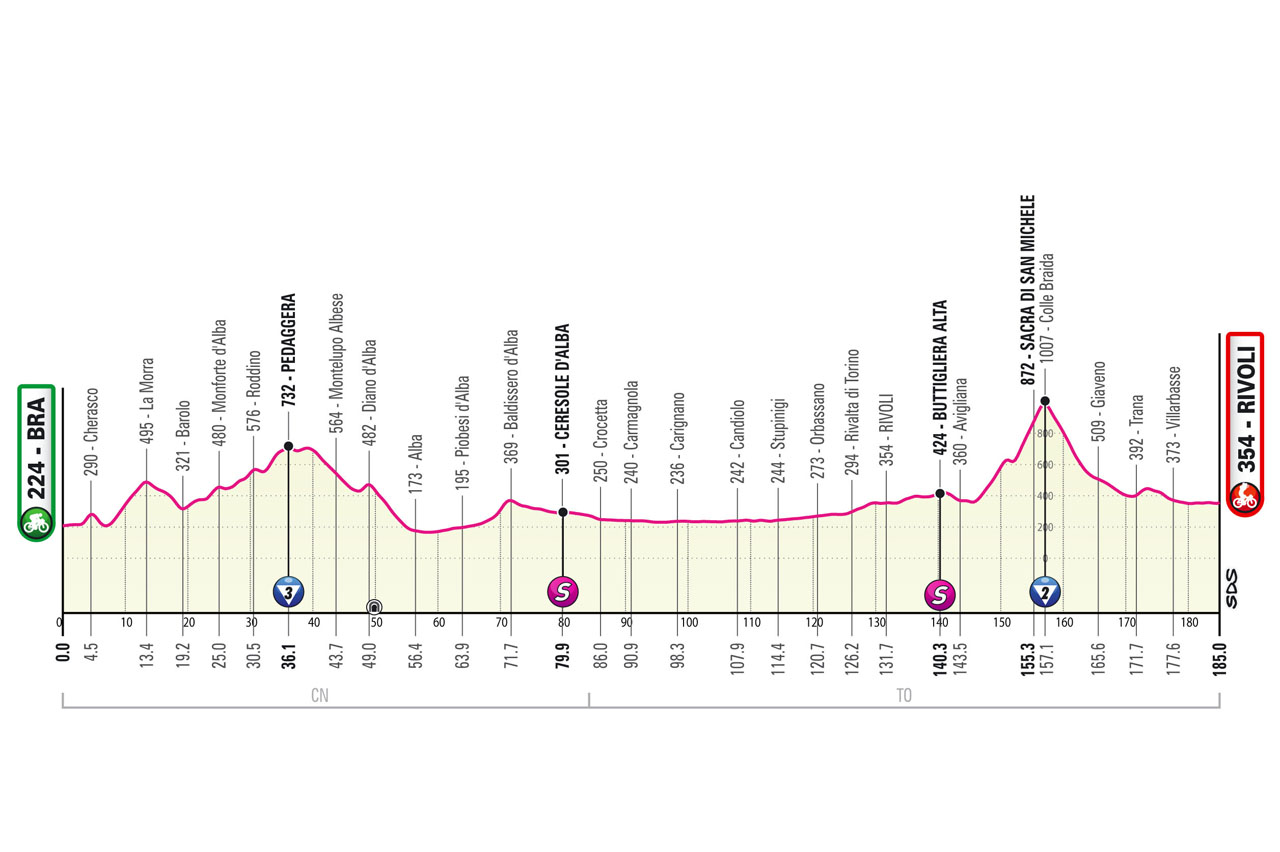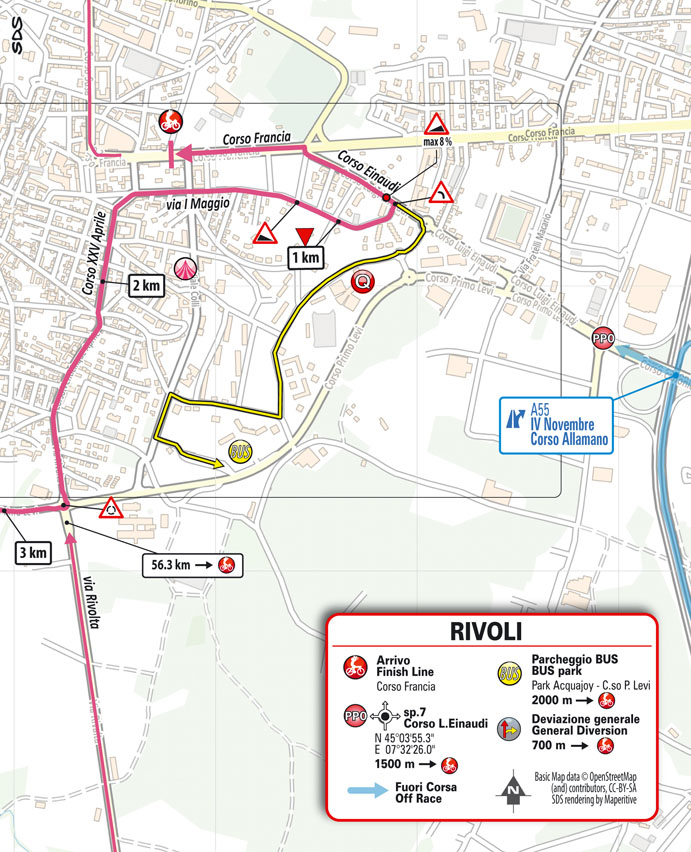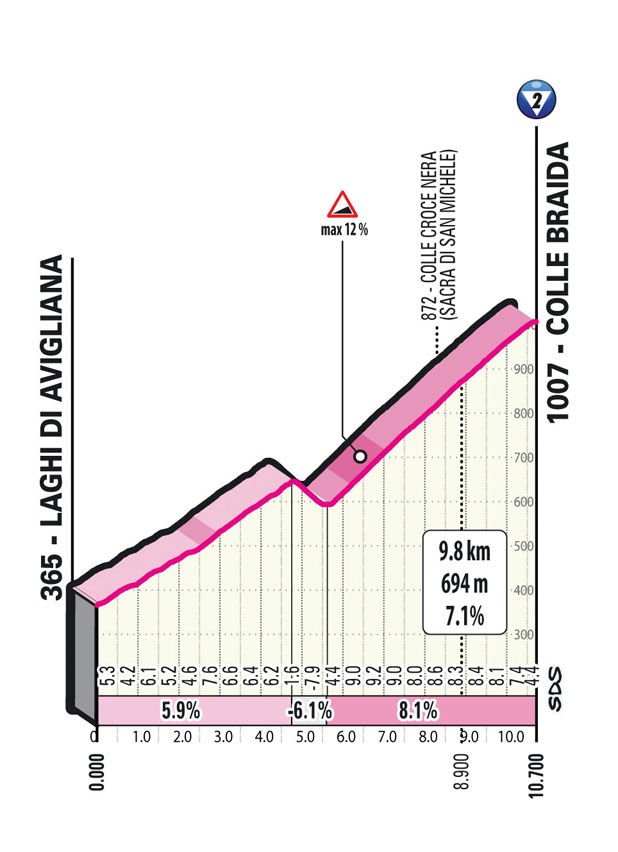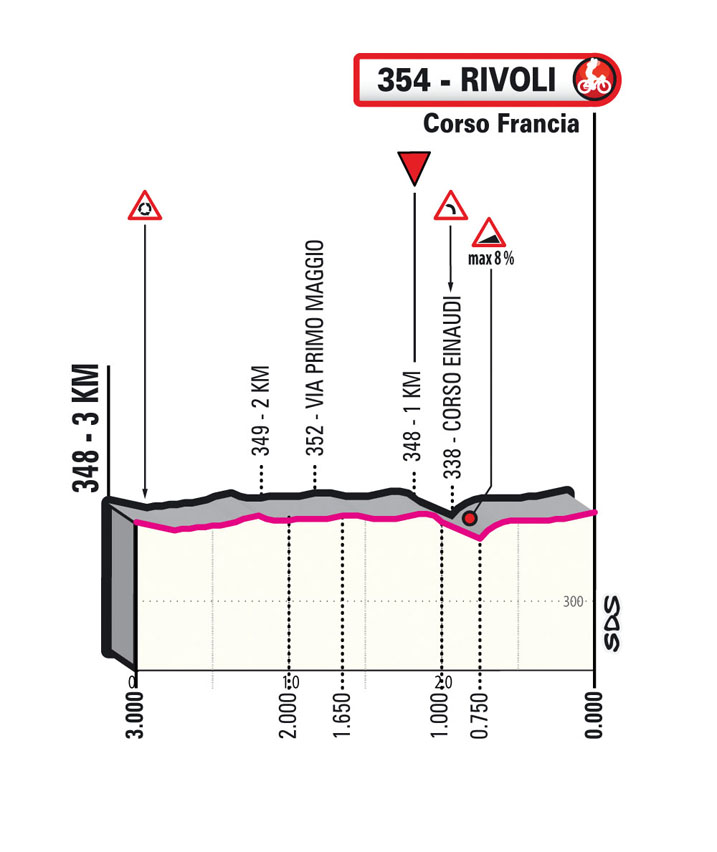profile
map
technical info
The stage route puts together a hilly section of 50 km, a flat drag from Alba to the first pass through Rivoli (75 km), and a final circuit (54 km) featuring the Colle Braida climb. The first section is wavy and winding, with endless bends and undulations. Past Alba, the roads are moderately wide and mostly straight. The urban areas along the closing circuit are dotted with roundabouts and traffic islands. The Colle Braida climb, past Avigliana, is 9.8 km long, with gradients above 7% and topping out at 12%. Along the descent and in the approach to the finish, the route is more intricate as it runs through urban areas.
Final kilometres
The last 3 km are inside the urban area of Rivoli. The roadway narrows between the ‑2km marker and the red triangle; the route then descends and bends, merging onto Corso Einaudi with 750 m to go. After a sharp left‑hander, the route rises at 8% gradients for 200 m. The home straight (400 m) is on tarmac road (9 m wide) and on a slight incline.
start / finish
climb detail
final kilometres
itinerary timetable
tourist info
Host city:
Bra
Overview
The town of Bra lies among Roero Hills and it is well known because of its culture, history and gastronomy specialties. The city of nearly 30,000 inhabitants is famous in Italy and around the world for being the homeland of the Slow Food movement, for its excellent sausage, for its international events and for being one of the cradles of Piedmontese Baroque. Thanks to events such as “BRA’S”, dedicated to its peculiar sausage, the international festival “Cheese – le forme del latte”, Da Cortile a Cortile, Bra Mon Amour, the Children’s Book Fair, Granfondo Bra-Bra (in its 30th edition in 2023) and the Easter and Easter Monday Fair, Bra has become a well-known tourist destination.
Food
Bra is also considered a land of good food and excellent wines known and appreciated even beyond national borders. First of all the “Salsiccia di Bra, a peculiar type of veal sausage to be eaten raw and the only one authorized directly by the House of Savoy. The other well-known product is cheese, which is celebrated every two years with the International Festival “Cheese – le forme del latte”
The great attention to the quality of life and sustainable mobility and many activities to promote and protect local trade and local craftsmanship has led Bra to be one of the four Italian municipalities that founded the CittàSlow movement. A commitment which is testified by the numerous national awards received during the years, including “Spiga Verde” and the certification of Free Waste Municipality by Legambiente.
Points of interest
Walking through the streets and discovering the squares of the city you will find the Town Hall, the church of Santa Chiara, a masterpiece by the royal architect Bernardo Antonio Vittone, the church of the Holy Trinity, also known as “Battuti Bianchi”, all considered to be admirable examples of Piedmontese Baroque, which here has one of its most admirable manifestations. Bra counts also several museums such as the Natural History museums, the Art, History and Archeology Museum and the Toy Museum, but also the Bike Museum that exhibits unique pieces both from the history of two wheels and from the Giro d’Italia and La Zizzola – Casa dei Braidesi which hosts a multimedia museum and a park with a breathtaking panorama.
In only five minutes by car you will find the village of Pollenzo, a UNESCO World Heritage Site since 1997, whose square overlooks an architectural complex of buildings that recall the ancient splendor of one of the Savoy residences. In these ancient premises is located the University of Gastronomic Sciences which involves students from all over the world; the characteristic tower that dominates the square houses The Bank of Wine.
Rivoli
Overview
Rivoli is 13 kilometers away from Turin and 102 kilometers from French borders, and it’s located at the mouth of Susa valley. Today, Rivoli has approximately 48,000 inhabitants. Thanks to its ancient historical origins, Rivoli is one of the most distinctive art cities of Piedmont. Corso Francia, a spectacular road designed in the XIV Century, connects Rivoli with Turin and is one of the main roards of Turin itself. Corso Francia, with a total length of 11.75 km, is the longest straight roads of Europe. Rivoli is a place of history, and its buildings from the various Centuries are proof of this, the most distinguishing of which is the Castello di Rivoli (the Castle), which has been one of the oldest residences of Savoy family. The Castello is the symbol of the city and hosts one of the world’s most appreciated contemporary art museums.
Food
Rivolotto is the name of a biscuit, the fruit of the art of a group of confectioners and bakers from Rivoli. Rivolotto has been recognized with the “De.Co.” (Denominazione Comunale, an important recognition given to typical products historically linked to a place to preserve their genuineness and territoriality. The biscuit is unique in design, shape and taste and is the ambassador of the local masters of taste at institutional events. It was one of Piedmont’s products of excellence at the ATP Tennis Finals in Turin.
Rivoli is home to Aziende Agricole (“Farms”) Scaglia, Massola and Comba, breeding cattle of the Piedmontese breed, winners of numerous recognitions and awards. Azienda Agricola Scaglia proposes a simple yet revolutionary idea of slow-fast food at zero km, which aims at valorising the short supply chain and the excellence of the territory. A new food concept that revolves around using only the meat processed at the farm, obtained from animals reared in the area.
CULINARY ACTIVITIES
‘La Maggiorana’ is the first school of culinary art in Piedmont, established in 1973 by Elena Maggiora together with her sister Erica, who was recognized at the young age of 19 years as the youngest Cordon Bleu d’Italia and pupil of the most illustrious experts of international haute cuisine, from Gualtiero Marchesi to Paul Bocause.
Courses at La Maggiorana explore Italian traditional recipes as well as re-elaborations and creations of Erika Maggiora.
Wine and beverage
The presence of Nebbiolo on the hills of Rivoli is documented by the oldest written testimony, drawn up on a parchment in custody at the Historical Archives of Turin, which records the production of the fine wine on the hills of the Castellania di Rivoli (the ancient castle) since 1266.
This document is part of the more than 3,000 rolls, known as Conti delle Castellanie,
i.e. the accounts rendered by a castellan, a local representative of the central power, to his lord.
The oldest extant one is the roll of the Castellania of Rivoli (1264-1266), where the castellan was Umberto de Balma. Accounts of A.D. 1266 report the following: “receptis de exitu vinearum de Nibiol hoc anno de CCC sextariis ” (in 1266, 12,205 litres of Nebbiolo wine are recorded as incomes).
This document unequivocally states that the first known cradle of Nebbiolo was Rivoli.
In 2017, over 750 years later, Pierro winery is once again cultivating Nebbiolo grapes on the same hills, bringing back a historical memory that was about to fade away.
Points of interest
Rivoli’s Castle
The Castle has been designed by Filippo Juvarra on Vittorio Amedeo II’s request in the early 18th century. In 1978 it underwent a massive renovation that combined the original structures with new modern facilities and opened to the public in 1984. Today, the Castle houses one of the most important Contemporary Art Museums of the world, with 38 exhibition rooms, and it has been awarded and recognised as UNESCO site.
Church of Santa Maria della Stella
Known as Collegiata Alta, it was originally the convent of San Domenico, built in the last decades of 1200 and strictly related to the Counts of Savoy. The convent has been renovated in 1682 and its sacristy is attributed to Filippo Juvarra. It is the city’s most important church. Inside the magnificent park of Villa Fiorito, the 13th Century tower bell is the last remnant of the ancient “chiesa del Comune”, which was consecrated in 1299 and partially destroyed in 1799. The restoration of the bell tower brought to light a 16th-century painted sundial on a façade.
Church of the Confraternity of Santa Croce
The Church of Santa Croce Confraternity was construed during 13th Century and was consecrated in 1521 as chapel for the Confraternity itself. Interiors are designed in the shape of a Latin cross, a high altar, a wooden choir and an organ, which was built by Concone’s brothers in 1730 and shows its original aspect, thanks also to the recent restoration works on it.
Conte Verde House
A unique example of a 14th-century stately home, today a civic venue for art exhibitions. Popular tradition has attributed this name to the building, as it dates back to the time of Amedeo VI of Savoy, known as Conte Verde. The façade, with a portico on the ground floor and a solarium with an open loggia on the top floor, has the peculiarity of being composed of terracotta decorations.
Palazzo Piozzo di Rosignano
Built in 1788 at the behest of Carlo Canova, chancellor of the Grand Priory of the Order of Malta, the Palazzo has passed through numerous changes of ownership. After the Count Cesare Piozzo di Rosignano, owner from 1859 to 1979, the Palazzo was acquired by the Municipality. The Palazzo contains a hall of honour, a monumental staircase, frescoed rooms and lounges, and a private chapel.
Rustico di Palazzo Piozzo di Rosignano
Next to Palazzo Piozzo di Rosignano, the Rustico was a rural residence in the mid-1800s. What makes the Rustico stands out is the neo-Gothic red tower, a true symbol over the decades. The Rustico hosts the Istituto Musicale (the School of Music) of the city.
Villa Cane d’Ussol
Villa Cane d’Ussol is a great sample of what a noble country home of the late 1700s looked like. The Villa was built in 1775 for the Count Giuseppe Cane d’Ussol. Interiors open to a magnificent staircase that leads to the ballroom, which is finely decorated in stuccos images of hunting trophies and garlands of flowers. The park is open to public.
Ex Mattatoio (the former Slaughterhouse)
A significant work of art in Rivoli by Eugenio Mollino built in 1907, the slaughterhouse was decommissioned in 1991. Today the building houses the Circolo della Musica.











